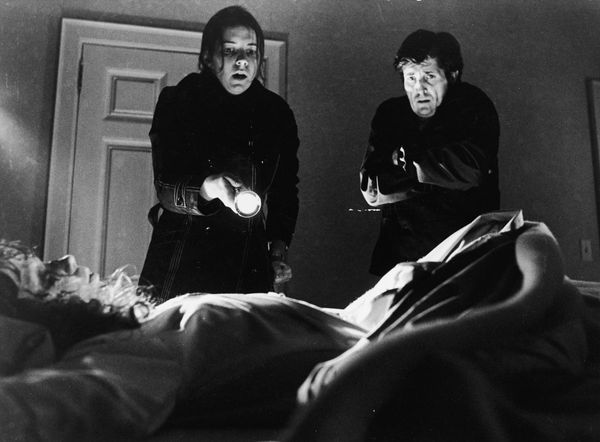
The Exorcist is certainly not the earliest movie to center on the topic of demonic possession, but for many, it's the first to come to mind. Based on the 1971 novel of the same name, written by William Peter Blatty, the story of a pubescent girl named Regan (Linda Blair), whose dabblings with a Ouija board lead to a dark entity inhabiting her body, was adapted to film in 1973 and, 50 years later, it still lands at the top of the list in terms of scariest horror movies — and the reason for this goes beyond the innate fear of Biblical-grade evil and projectile vomit.
Ever since the story of Creation cranked through the Gutenberg press, men have been taught to fear anyone who presents themselves as a gender outside of their own. You could say "women" here. You could say "girls." But age is irrelevant, as is biology. The fear is essentially anyone who was not born with one functioning ding-dong with which to rule the world, planting seeds hither and yon. Anything beyond that, to them, is a terrifying unknown to be used as a tool for their own ego and interests or, when not that, managed and dealt with like livestock or a project car.
This is the story of man, as told by the Bible. And this is the story of "not man," as we've seen in everything that's followed, including "The Exorcist" franchise and the latest addition to it, "The Exorcist: Believer," which poses the question: What's scarier to a man than a hysterical girl? TWO hysterical girls!
In the 1973 film, Regan first begins to show signs of possession when she crashes a get-together that her mom (Ellen Burstyn) is having by creeping downstairs and peeing on the floor. Later, when the demonic forces within her are in full pea-soup-chaos mode, she sends the priests who have come to exorcise her grabbing for the holy water and clutching for their rosaries when she shoves a crucifix up her privates and tells one of them that his dead mom "sucks c**ks in hell." This says a lot.

The themes of "The Exorcist" films are as age-old as the Bible itself. Women and girls fear for and can relate to what other women and girls are going through, mentally and physically. While men are, usually, only willing to or capable of worrying about what's going in and out of women and girls. And this could be a variety of things: A penis, a baby, a Coors Light, swear words, multiple ear piercings. Whatever. Anything that taints their preconceived notion of how they should be. And more specifically, how they should be for them.
When I was very young, perhaps even before I saw my first movie, I knew the story of "The Exorcist." My mom, disturbed for years after seeing the film during its first run in theaters, recounted the scene where Regan pees on the floor in a compulsive fashion, like she had to get it off of her chest, this horrible thing she saw so long before her own daughter was born. And this from a life-long nurse who worked at both a women's prison and multiple old-age homes in her life and had seen all the poop, pee and puke that the universe could throw at her. I mean, I remember her telling me about having to shimmy a whole apple and a sealed package of Lee press-on nails out of a woman's vagina during intake at the prison once. But this particular scene of a young girl — someone's daughter — being very much not okay on the bathroom front is what rattled her most about this iconic horror film.
My dad, who was her date at the theater when she first saw it, has never mentioned the movie to me at all, to the best of my recollection. This from the man who, when told that I'd started my monthly miseries in the fifth grade, said "congratulations," left the house, and returned hours later to present me with a Batman magazine as, like, a reward. It tracks. Beyond "The Exorcist," two films that would be apex frightening for a man would have titles like "Improperly disposed of Maxi-pad." Or, "Someone is touching your daughter's crotch."

And Blatty, the author of the book that started this all, had a window of opportunity to stop this pattern from being a thing, but didn't. One of the main inspirations for his novel was the real-life possession of a 14-year-old boy in the 1940s, documented under the pseudonym "Roland Doe" or "Robbie Mannheim." What could have been the reason for getting a bolt of creativity from that case, but changing the gender from male to female in his own version of it? Or for Friedkin to follow suit in his adaptation? Same reason why "The Exorcist: Believer" offers absolutely nothing to the franchise other than doubling down on the gynephobia with two possessed girls, rather than one. Devil's in the details. And so is the patriarchy.







